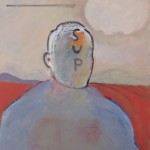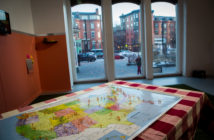Take for example the dates of Nathaniel Wyrick's "Way Back on the Shelf:" 1982-2014. That's pretty much a whole life span, represented by canning jars of various materials on a series of shelves. Facing the wall is an old kitchen table and a wooden chair, plus a bottle of booze and a glass. Sitting down, one is prepared to experience a projected video as a mirror-image of self-examination, nostalgia, and faulty memories.
Christian Meade, another sculptor, also accumulates curios on shelves, and builds odd furniture out of reclaimed pieces of wood. He's an antique shop recycling tiny treasures. Clara hy Lee projects landscape scenes on still-lifes like flower bouquets; the saturated colors and mysterious textures read as exotic fish tanks, full of well-guarded and priceless possessions. Literal show-places are recorded by Lydia A. Harris' images of "Collier Heights," a black suburb of Atlanta renowned for its carefully and particularly decorated homes. Yes, we're at the point where mid-century kidney-shaped coffee tables and zebra print rugs can apply for protected historic status.
Other photographers are concerned with the larger environment, but it's definitely culture more than nature that is of interest. Aaron John Bourque's explorations of the Boston Harbor Defense Reclamation Project focus on that liminal place between the water and the ocean; but it's also an urban place, as full of graffiti and concrete bunkers and asphalt paths as it is of trees and birds and water. It's a war-zone of a sort, where different agendas compete for dominance. The dominance, on the other hand, is clear in Dayna Rochell Stanley's "Holiday Park." Her colorful (especially lemon yellow) vacation trailer communities reveal incongruous attempts at luxury for the budget-conscious, with poignant sights like puppies confined in cages in tight quarters, and shared swimming pools and picnic tables similarly abutting their neighbors on every side.
It's a more tasteful and truly elegant lifestyle that Emil Cohen depicts, but his images of the gay community surrounding the Manhunt website chronicle both wealth (a stylishly minimal mansion with just the right accent of Greco-statuary) and a subset of prim and preppy (but bearded) web geniuses who seem both allied to and at odds with an older institution like the Paradise Bar. What's the connection between a group of men bathing at a swim club in spiffy trunks, and the drag and dancer mementos decorating the bar back at the club? Or has it been lost? One thing both scenes seem miles away from: gay marriage.
Of the painters, I'm happy to find abstraction alive and well, if always through a personal lens. Debra K. Jayne uses familiar pieces of Boston modernist architecture to anchor her kaleidoscope explorations into brightly colored geometric patterning. Cody Justus bases his sign-like geometries on frequent road trips, but his facades are blank, all the letters missing. His two-dimensional forms are often just out of true, trapezoids rather than squares, following a tertiary color-scheme and a logic all their own. Also using trapezoids is Michael MacMahon, but his black patches inhabit dream-like worlds filled with non-descript men in suits.
The point of view is sort of like looking into a Sims game (IE, omniscience) but the titles of these inscrutable pieces are quotes from well-known movies. Perhaps MacMahon says it best himself when he describes his inspiration as Kubrick's "Dr. Strangelove" meets Kazimir Malevich, because, yeah, I can see it. More readily accessible are the pop-art flavored works of Gage Delprete; at least I think I'm seeing familiar items like spoons and popsicles, if swollen to iconic size and floating in fields of textured monochrome paint.
A very postmodern thing to do is to base one's work on that of other artists, but that too is sort of a homely, studious activity. Which might explain Khaldoun Hijazin's grid of fragments of Renaissance and Baroque still life and portrait elements, interspersed with golden Arabic phrases in "Gilded Honor 1." I'm not sure what might explain Yoshiaki Otsuka's fantasy landscapes, except that these castles and moats and artificially green hills look like amusement parks before the public has been admitted for the day.
At the center of the space, and the show, is Matthew Shropshire's zoetrope, a spinning device that allows one to view still images as in a movie. The originals, from the 19th century, were cinema precursors, but here what we view are paintings in a circular room, based on an animated film Shropshire made of his abstract painting process. Circles within circles, but the somewhat steampunk device at the center features white gloves for viewers who want to spin it. They're not there to protect the sculpture (which looks indestructible), but to keep grease and lubricant off the visitors. Because what good host lets his guests get covered in goo?
- Matthew Shropshire, Temporal Painting (still), 2014. Animation, oil on glass. Courtesy of the SMFA.
- Emil Cohen, Paradise on a Saturday Night, 2014, Archival Ink Jet Print. Courtesy of the SMFA.
- Gage Delprete, Con-verse, 2013. Oil on canvas. 18×24 inches. Courtesy of the SMFA.
- Christian Meade, A Chair for Bucky, 2013. Augmented chair. Courtesy of the SMFA.











